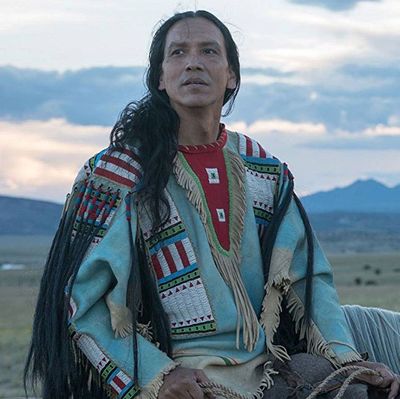
“Woman Walks Ahead” is the Native American name given to Catherine Weldon, a hard-charging, 44-year-old Swiss-born divorcee who traveled with her 12-year-old son (from an affair with a married man) to North Dakota in 1889 at the behest of the National Indian Defense Association (NIDA) to work as an aide to the Lakota Sioux Indian leader Sitting Bull — and against the proposed Dawes Act, which offered U.S. citizenship to Native Americans willing to separate themselves from their tribes and would, if passed, sell half their land out from under them. She was the sort of unruly, politicized woman that traditional, male-driven Western films have paid little mind.
That has changed, marginally for the better, with Woman Walks Ahead, directed by Susanna White from a screenplay by Steven Knight. White/Knight make Weldon (Jessica Chastain) a widow with no son and no evident affiliation with the NIDA. She is merely a dedicated painter who travels alone to the Dakotas to convince Sitting Bull (Michael Greyeyes) to pose for a portrait and is swept up in the fight against the Dawes Act. Her mere presence inspires her subject to stop farming potatoes, dress once again in his traditional Lakota regalia, and move closer to the radical religious Ghost Dance movement. The air is filled with sexual tension (Greyeyes is quite the hunk) but the story, however Hollywood-ized, does stop short of consummation. In any case, tragedy beckons. The Ghost Dance of 1890 would end at Wounded Knee.
The problem with Woman Walks Ahead is not that it doesn’t stick to the historical record — which most of us didn’t know anyway, Weldon’s grave being among the more obscure in Brooklyn’s Green-Wood Cemetery. (That, of course, will change now, even if the film flops.) It’s that what it does present is so blandly tasteful. Weldon lived a messy, passionate life (Caroline Weldon was a name she picked for herself) and refused in the end even to Stand by Her Lakota Man, getting so fed up with Sitting Bull’s obliviousness to the larger U.S. strategy that he threw her out of his camp.
The film ratchets down that messiness. It has feminist underpinnings, of course: It begins with a corset being tightened, and Weldon reveals that her rebellious spirit (and fear of horses) was born when her father locked her in a stable at age 8 for being insufficiently ladylike — he wanted to “break her.” But she’s also a weeping romantic, cast to the side as her man ends up on the wrong side of a rifle. That man, meanwhile, conforms too well to the standard martyr template. When Greyeyes speaks in English (“Your society values people by how much they have, ours by what we give away”), it’s with a slight sigh at the end of each line to convey spirituality. He’s a little dull.
The most interesting characters are the white people, whose racism is flecked with shades of gray. As the envoy from Washington tasked with selling the Allotment scheme to the Lakota, Sam Rockwell is fascinatingly irreducible, his intense hatred mixing with his even more intense guilt. Ciaran Hinds as the “Indian Agent” charged with keeping tabs on the tribes suggests a man who has twisted himself up to be able to live with all the contradictions. (He has a Native American wife, who translates his appalling edicts to her people.) Bill Camp brings his usual three layers of subtext to the saturnine General, who respects Sitting Bull as a warrior enough to want him dead and buried, and who realizes that the best way to wipe out the Lakota would be for the U.S. to lose the fight to convince the tribes to support the proposed allotments. The movie’s most exciting moment comes when Weldon realizes that she has been played — that in helping turn the tribes against the Dawes Act, she has won the battle and lost the war, since the U.S. would now have cause to attack. That’s the moment when Woman Walks Ahead should get really good but turns, instead, into a weeper.
Is Chastain getting less interesting? She began her career taking all sorts of varied roles, from the Candide-like protagonist of the underseen Jolene to the narcissistic trophy wife in The Help, and she stripped herself down to pure, righteous anger in Zero Dark Thirty. She has too many dimensions to corset herself with virtuous Great Lady roles in handsome period pieces like Woman Walks Ahead. As an artist, she’s in danger of being Woman Behind the Curve.


